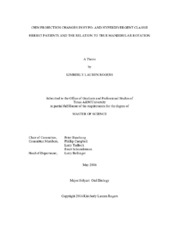| dc.description.abstract | The purpose of this study was to examine the relation of chin projection changes and true rotation in hypo- and hyperdivergent patients.
The treated group consisted of 45 growing Class II Division I patients (23 boys, 22 girls) treated by a single practitioner with stainless steel crown Herbst appliances, followed by fixed edgewise appliances. The untreated control group consisted of 45 Class II Div I subjects (23 boys, 22 girls) who were matched to the treated sample based on age, sex, and pre-treatment MPA (SN-GoMe). Pre- and post-treatment lateral cephalograms were traced. Cranial base and mandibular superimpositions were performed to evaluate T1-T2 changes and true mandibular rotation. Cephalometric changes between the treated and control groups were compared.
The primary effect of the Herbst in terms of maxillomandibular correction was in the maxilla. The Herbst produced a significant maxillary growth restriction or a “headgear effect.” The rotational effects of the Herbst were different in hypo- than hyperdivergent patients. Hyperdivergent patients experienced a deleterious backward true mandibular rotation with Herbst treatment, while hypodivergent Herbst patients and untreated hypo- and hyperdivergent controls had forward true mandibular rotation. The chin did not come forward any more with Herbst treatment than what was expected to occur in untreated Class II individuals.
Hypodivergent patients may benefit from the Herbst “headgear effect” and may be able to overcome the negative rotational effects of the Herbst, but treatment does not advance the chin position any more than if the patient was untreated. Hyperdivergent patients also experience a slight “headgear effect,” along with deleterious backward rotation and increased facial height, which worsen facial esthetics. Because of this, hyperdivergent patients are poorly suited for Herbst treatment. | en |


